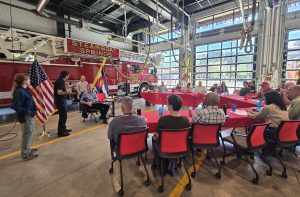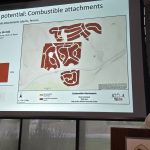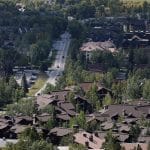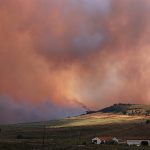Strong partnerships, waning federal funding focus of regional wildfire meeting
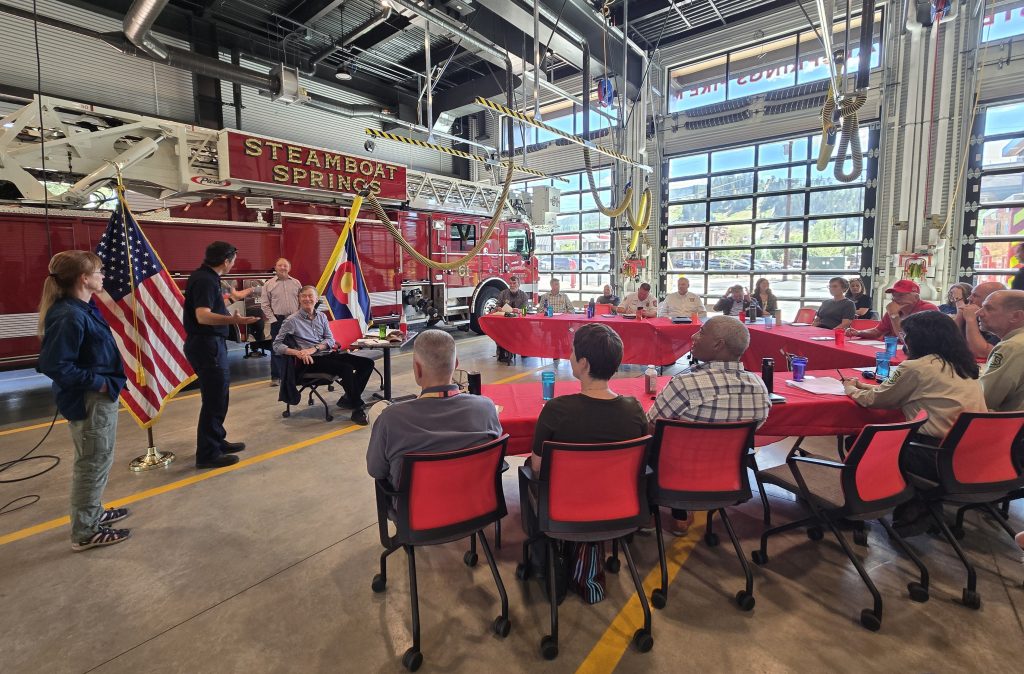
Suzie Romig/Steamboat Pilot & Today
U.S. Sen. John Hickenlooper of Colorado joined dozens of wildland fire experts from local, regional, state and federal agencies Tuesday afternoon sitting on folding chairs inside the bay of the downtown Steamboat Springs fire station to try to elevate the needs of wildfire resources and mitigation.
Comments from many of the fire agency speakers included the fact that partnerships — such as Good Neighbor Authority agreements — among firefighting, wildfire mitigation, education and emergency management agencies and organizations are strong. But many leaders voiced concern about the loss of federal funding impacting those collaborative efforts.
“We are doing really well with our partners,” said John Twitchell, supervisory forester with the Colorado State Forest Service office in Steamboat. “The challenges we faced in the last year have been more due to the fact that, ‘Is money coming, are we able to that?'”
“The direction is the states are going to do more, but there’s no resources coming in to do that,” Twitchell said. “And if there were resources, it is critical that there is somebody at the other end of the phone when we call our federal partners.”
After listening to each speaker, Hickenlooper noted in wrap-up comments, “I don’t feel very optimistic about the funding from the federal government.” He urged officials to join him in a proposed, professionally facilitated charrette, or stakeholder meeting, to determine top priorities to fight the wildfire crisis.
Hickenlooper said it is vital to determine top funding priorities that make the most difference in wildfire mitigation — including efforts made before fires happen, when mitigation work can cost one-tenth of the cost of post-fire work.
“What we are going through now as a country — I don’t appreciate the way it’s done, I think many times it’s cruel, and it doesn’t have to be cruel — but tightening our belts is not a bad idea,” Hickenlooper said. “What we have to do is figure out how to come up with a way of measuring priorities. The money we get, where is it most important?”
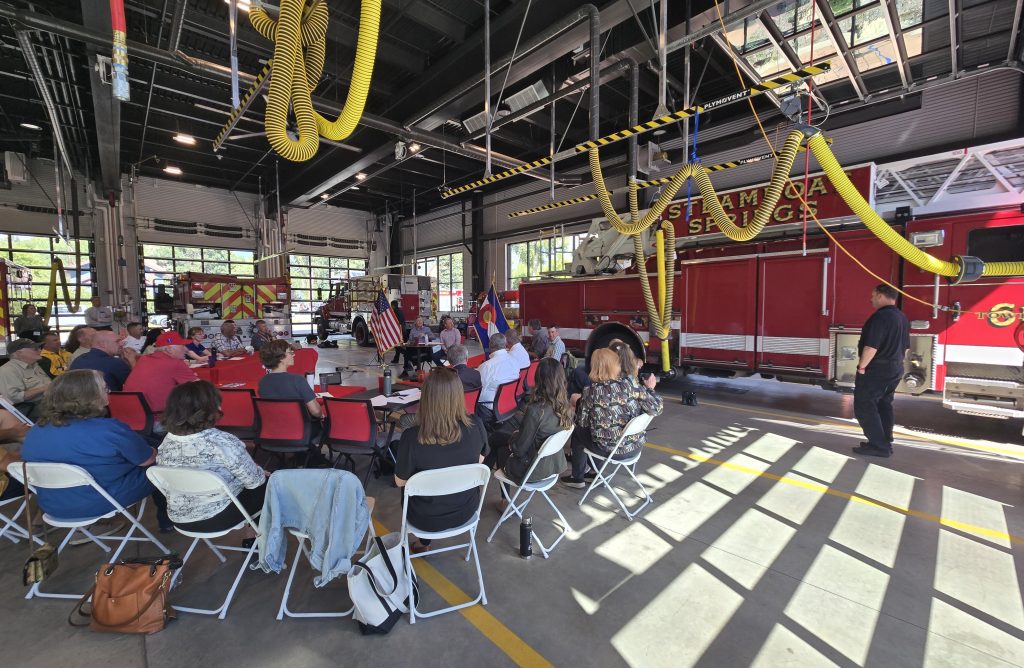
The senator encouraged the group of fire experts to participate in a proposed two-day charrette to create a statewide working project for wildfire funding priorities.
“It’s a push of establishing what is the priority for funding — what do you need to pay for first, where do you get the most bang for the dollar,” Hickenlooper explained.
“I heard every one of you talking about collaboration,” Hickenlooper said. “That’s going to be part of the persuasion because that is the best way we can invest, is to invest in things where we have an alignment of self-interest.”
The conversation highlighted how wildfires are continuing to become larger, hotter and more destructive due to worsening negative impacts of climate change, previous decades of forest fire suppression, and more homes and infrastructure built within the wildland-urban interface.
Michael Judson, Hickenlooper’s press secretary, promoted the meeting as “a regional bipartisan roundtable to discuss the growing wildfire crisis” and an opportunity “to talk updates on recent Colorado wildfires, impacts by the Trump administration on budgets and staffing, and how we can better support local wildfire and emergency mitigation planning and disaster recovery for Colorado communities.”
Hickenlooper was scheduled to meet with wildfire officials in Moffat County on Wednesday, and a similar regional meeting is planned for southwestern Colorado next week.
“This is certainly timely,” said meeting moderator Todd Hagenbuch, Routt County CSU Extension director, who is helping ranchers with livestock impacted by the ongoing Crosho Fire in southern Routt County.
Smoke moved back into Steamboat Springs on Wednesday as the new Derby Fire, located some 13 miles north of Dotsero in far northwestern Eagle County, blew up to 839 acres by midday while the Lee Fire continued to burn in Rio Blanco County.
Hickenlooper and other fire officials discussed how wildfire mitigation efforts on all levels, including homeowner participation, are important due to increasing damage from wildfires that could lead to a mortgage and property insurance calamity.
“We are going to go through a mortgage crisis and a home insurance crisis because huge chunks of America are not going to be insurable,” Hickenlooper said. “People’s property values will drop.”
“It’s very frustrating to be in Washington where they spend 90% of their time talking about petty, external, peripheral issues, and they don’t sit down and say, all right, this is an issue that’s affecting two-thirds of the country,” Hickenlooper said. “We have a whole lot of information that we are not sufficiently putting to work.”
As a Steamboat Springs Fire Rescue truck pulled out of the station bay on a call, Kevin Klein, director of the Colorado Division of Homeland Security and Emergency Management, outlined the increasing severity of fires in Colorado.
Klein noted that since 2000, Colorado had 60 fires greater than 10,000 acres, compared to only eight of that size from 1984 to 1999. He said five of Colorado’s largest wildfires happened in the last five years, “and that’s pretty telling.”
Hickenlooper told the group he believed wildfire is one of the “three or four most important things that face Colorado.” After the meeting, he said other key topics for the state include keeping the U.S. Space Command in Colorado and supporting the state’s aerospace industry; supporting the foundational agriculture industry; and the challenge of achieving and maintaining excellence in public education.
To reach Suzie Romig, call 970-871-4205 or email sromig@SteamboatPilot.com.

Support Local Journalism

Support Local Journalism
Readers around Steamboat and Routt County make the Steamboat Pilot & Today’s work possible. Your financial contribution supports our efforts to deliver quality, locally relevant journalism.
Now more than ever, your support is critical to help us keep our community informed about the evolving coronavirus pandemic and the impact it is having locally. Every contribution, however large or small, will make a difference.
Each donation will be used exclusively for the development and creation of increased news coverage.

